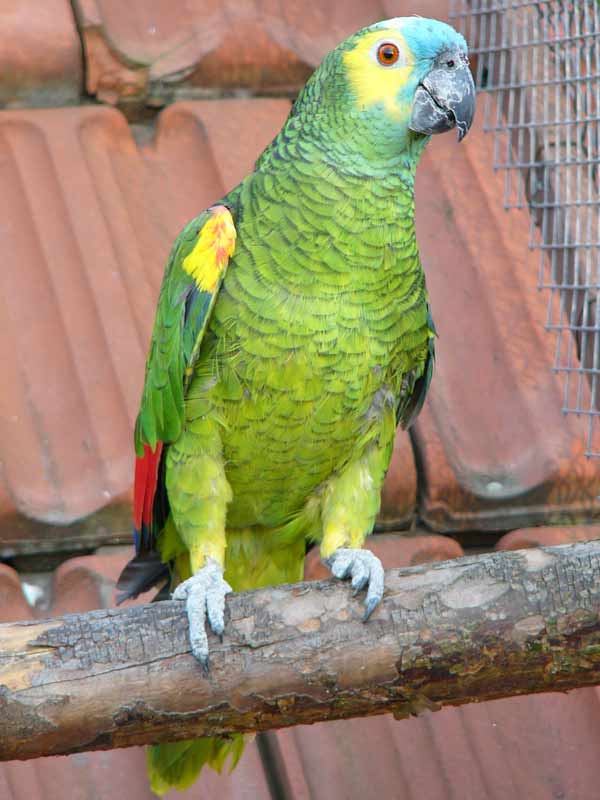
Blue-fronted amazon, orTurquoise-fronted amazon, orBlue-frontedparrot (Amazona aestiva)
Phylum —chordata
Class — aves
Order — psittaciformes
Family — psittacidae
Genus – amazona
Appearance
The Turquoise-fronted amazon is a mainly green parrot about 38 cm (15 in) long. They have blue feathers on the forehead above the beak and yellow on the face and crown. Distribution of blue and yellow varies greatly among individuals. Unlike most other amazon parrots, its beak is mostly black. There is no overt sexual dimorphism to the human eye, but analysis of the feathers using spectrometry, a method which allows the plumage to be seen as it would be by a parrot's tetrachromatic vision, shows clear differences between the plumage of the sexes. Juveniles of parrots are duller and have dark irises.
Habitat
The range of the Turquoise-fronted amazon extends over eastern and northern Bolivia, eastern Brazil, Paraguay and northern Argentina.
Behavior
Blue-fronted amazons are monogamous, social birds that stick close to their flock year-round. They are non-migratory birds that may occasionally make local migrations to areas with more abundant resources. They forage in flocks during the non-breeding season, and in mated pairs while breeding. They are diurnal birds, so during the night they roost together in tree-top canopies until morning when they begin to forage. They blend into their surroundings when arboreal, and can only be recognized when they produce their high-pitched calls.
Diet
Blue-fronted parrots primarily eat native seeds, fruits, nuts, leaf sprouts, and flowers from the Amazon. They are widely known for being a crop pest, particularly to citrus crops.
Reproduction
The Turquoise-fronted amazon nests in tree cavities. The oval eggs are white and measure around 38 × 30 mm. There are usually three to five in a clutch. The female incubates the eggs for about 27 days and the chicks leave the nest about 60 days after hatching.
In captivity
Blue-fronted amazons are expected to live up to 70 years in captivity.
These birds are highly intelligent and social, and they need regular human interaction. Don't adopt an amazon parrot if you don't have plenty of time to spend with it.
The more activities around the house you can include your parrot in, the happier it will be. Whether you're watching TV, cleaning up, or eating dinner, the Blue-fronted will want to be part of the action. A portable play stand that you can move from room to room makes a good exercise area. Your bird will amuse you with his acrobatic antics.
The minimum recommended cage size for an active bird like a Blue-fronted amazon is a 3-foot cube, though larger is better. If you can't get a sizeable cage, try to compensate by allowing it extra out-of-cage time each day.
All amazons are active parrots and the Blue-fronted should be allowed a minimum of 3 to 4 hours per day outside the cage. This activity allows it to play and stretch his wings and to be part of the family.
These birds love to climb and chew, so amazon parrot owners should provide their pets with plenty of toys, including ladders and ropes to swing on. Keep a few extra chew toys ready to replace any that become too worn.
Bath time is a special joy of the Blue-fronted amazon. Provide a water bowl for splashing around to its heart's content. Some birds like to be spritzed with water while others may beg for a bath in the sink. Follow your bird's lead and use it as another bonding opportunity beyond speech and trick training.
Like all parrots, Blue-fronted amazons need a varied diet that mimics their natural foods.
A healthy diet should consist of high-quality pellets, a quality seed mix, and daily servings of fresh, bird-safe fruits and vegetables. Do not feed your amazon avocados and chocolate as they are toxic to birds.
Specially formulated pellets are an ideal food and should ideally represent approximately 75 to 80 percent of the bird’s diet. Fruits, vegetables, and greens should account for about 20 to 25 percent of the daily diet. Seeds and nuts are high-fat foods that you can offer as occasional treats. Start by giving your bird 1 cup of pellet-based parrot mix and a 1/2 cup of fruits and vegetables daily, then adjust according to their appetite.
Essentially, many people foods that are considered healthy are okay to feed these parrots in moderation, including chicken.
 Russian
Russian
 English
English


















